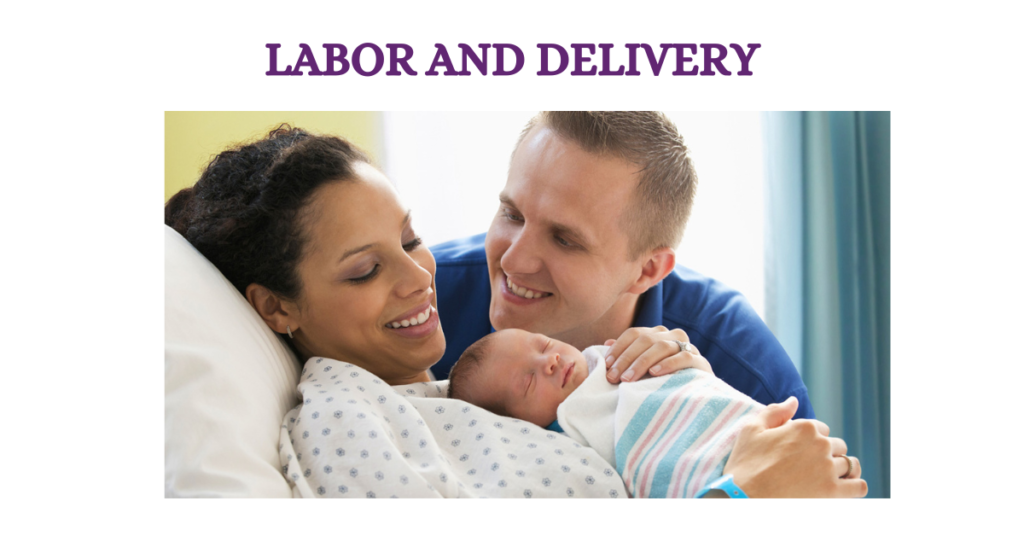A Journey through Labor and Delivery: The Miracle of Life
A Journey through Labor and Delivery: The Miracle of Life
Yes, certainly! Every birthing method has its philosophy and tactics, as well as approaches to labor and delivery. Remember that selecting the best approach depends largely on a person’s tastes, health, and cultural background. Some typical childbirth techniques are as follows:
Stages of Labor and Delivery
While each birth is unique, all women going through childbirth go through three stages of labor and delivery: pushing, pushing, and delivering the baby; the third stage is delivering the placenta. You may require a cesarean (C-section) delivery if a vaginal delivery becomes risky for you or the baby. Your baby’s birth may occur in a few hours or a few days.
The following are the three primary phases of labor and delivery:
- Labor: This stage consists of three stages: transitional, active, and early labor.
- Pushing and delivery: Your baby will arrive at the conclusion of this stage.
- Delivery of the placenta: At this point, either you or your OB-GYN will push the placenta out.
Different Types of Delivery options
It’s difficult to predict with certainty what will happen during childbirth. The majority of people have an idea of how they want their labor and delivery to proceed. It’s helpful to know that there are a variety of delivery techniques used by pregnancy care providers. Among the delivery types are:
- Vaginal delivery.
- Assisted vaginal delivery (vacuum or forceps).
- C-section (Cesarean birth).
- VBAC (Vaginal birth after cesarean)

Lets have a detailed exploration of the different types of delivery:
- Vaginal Delivery
In this case, your baby is born through your vagina or birth canal. It is the most common delivery method. Most biological women can use it safely. If painkillers are helping, you can choose to give birth. You may also choose “natural childbirth,” which is the phrase for a vaginal delivery that does not involve the use of painkillers or medications to induce or hasten labor.
A vaginal delivery has three stages: labor, birth and delivering the placenta
Some benefits of a vaginal delivery include:
- Faster recovery.
- Safest for the pregnant person and the baby.
- Lower rates of infection.
- Babies are at lower risk for respiratory problems and have a stronger immune system.
- Lactation and breastfeeding are usually easier.
Natural vaginal birth: A vaginal birth that occurs naturally without the use of medication to induce labor. It is optimal to go into natural labor at 40 weeks of pregnancy.
Induced vaginal delivery: It refers to the use of medications or other methods to induce labor and prepare the cervix for delivery. Pregnancy care experts frequently advise inducing labor when a woman is past due or has a medical problem. The medication Pitocin®, a synthetic version of oxytocin, is typically used to induce labor.
2. Assisted vaginal delivery (vacuum or forceps)
Your physician will use forceps or a vacuum device to extract your baby during an aided vaginal delivery. Assisted births frequently take place when:
- You’ve been in labor for quite some time.
- Your labor isn’t going forward.
- You are too exhausted to keep on.
- There are indicators of distress from you or your child.
- Only under specific circumstances do assisted deliveries take place.
Assisted vaginal delivery is performed with the help of tools or procedures to aid in the birth of a child. They may include:
Forceps delivery Sometimes the doctor has to use forceps (instruments resembling large spoons) to cup your baby’s head and help guide the baby through the birth canal.
Vacuum Extraction Delivery using a vacuum is comparable to delivery using forceps. The infant is gently removed from the birth canal by the doctor using suction to put a plastic cup to the baby’s head.
Episiotomy. This is a surgical cut in the tissue between your vaginal opening and anus. The perineum is the name of this tissue. Large vaginal tears during childbirth were originally considered to be averted by it, but more recent research reveals that this is no longer the case. Many modern doctors will only perform the surgery if it is really necessary to deliver your baby swiftly.
Amniotomy. Another name for this is “breaking your water.” The amniotic sac is opened by the doctor using a tiny plastic hook. There can be a warm fluid gush.
Induced labor. This is the time when the doctor induces contractions in order to delay the onset of labor. If they have concerns about the health of you or your child, they might recommend this.
3. Cesarean Section
A vaginal birth might not be feasible in every situation. Cesarean Section may be required to ensure the security of both you and your child, particularly for one or more of the following reasons:
- Your infant is not lying with their head down. Rather, they are in a transverse or breech position.
- Your medical condition makes a vaginal birth risky.
- The baby’s size prevents it from fitting through the pelvis.
- Your infant is not feeling well.
- There are multiple babies inside of you.
- You are having placenta previa in which the placenta covers the opening of your cervix.
- The umbilical cord slips through your cervix before the baby does.
- In the previous case, you’ve had a Cesarean Section
Delivery risks involving C-sections
A cesarean birth has some dangers, just like any surgery. A cesarean delivery carries a lower risk than a vaginal delivery overall.
They could consist of:
- A thrombus that could rupture and enter the circulation (embolism).
- Infection
- Loss of blood or the requirement for transfusions.
- Damage to the bladder or bowel.
- Longer hospital stays and longer healing times.
- Abdominal clinging.
Benefits of C-Sections
A cesarean delivery allows some people more control over the due date, which is why some choose it. An elective C-section is what this is known as. Medical professionals generally discourage performing elective C-sections for non-medical reasons, however some may permit them. Medical need is the primary reason for C-section births in most circumstances.
When compared to vaginal delivery, a C-section has the following advantages:
- Reduce the possibility that your baby will suffer trauma during vaginal passage.
- Reduced chance of oxygen deprivation for your newborn at birth.
- Potentially reduced risk of sexual dysfunction or incontinence.
4. VBAC (Vaginal birth after cesarean)
It’s possible for you to give birth to your next child naturally if you’ve already had a cesarean. This birth is a vaginal birth after cesarean, or VBAC. The worry is that the pressure of labor during a vaginal delivery could cause your uterus to open up (rupture) along the previous scar from the C-section because a surgical cut leaves your uterus scarred. This is the reason why your physician can’t try a vaginal delivery following a C-section unless specific requirements are completed.
Can I become pregnant naturally after having a C-section?
After a cesarean birth, some women may be able to give birth naturally again in the future. Your chances of having a successful vaginal birth after cesarean (VBAC) are excellent if you fit the following requirements:
- During your cesarean section, your physician performed a modest transverse incision. Unless there’s an urgent need to deliver your baby, this is the standard method for performing a C-section.
- There are no more uterine anomalies or scars on you.
- You’ve given birth vaginally before.
- You have never before experienced a uterine rupture.
CHALLENGES OF LABOR AND DELIVERY FACED BY THE PREGNANT WOMEN AND HEALTH CARE PROVIDERS
Expectant mothers and healthcare providers face a variety of difficulties during labor and delivery. Among the frequent difficulties are:
- Pain Management: Managing pain successfully during labor while keeping the mother and the infant safe is a big issue. Labor is frequently linked to severe pain. Medication, epidurals, and complementary therapies including massage and breathing exercises are available for pain management.
- Obstetrical complications: Fetal discomfort, troubles with the placenta, and problems with the umbilical cord can all occur as complications during childbirth. To ensure a safe delivery, these problems must be promptly identified and managed.
- Prevention of Infections: To avoid difficulties for the mother and the newborn, the labor and delivery environment needs to be continuously managed for infection control. To reduce the danger of infections, healthcare providers need to follow stringent guidelines.
- Discussing and Making Decisions: It’s critical that the expectant mother and the healthcare staff communicate effectively. To safeguard the health of the mother and the unborn child, informed decision-making about treatments, procedures, and potential complications necessitates open communication.
- Maternal Bleeding: Abnormally high bleeding during or following childbirth can be extremely dangerous for the mother’s health. Healthcare professionals need to be ready to respond quickly to and treat maternal bleeding.
- Neonatal Intensive Care for Infants: Some newborns may need resuscitation right away because of problems like poor Apgar scores or trouble breathing. For the newborn’s wellbeing to be guaranteed, healthcare professionals need to be prepared to act promptly and effectively.
- Emotional and psychological difficulties: The expecting mother may experience emotional difficulties throughout labor and delivery. Stress, anxiety, and fear can all affect how labor goes. Important facets of maternity care include addressing psychological issues and offering emotional support.
- Postpartum Complications: The postpartum phase is not the only challenging time after delivery. Problems like postpartum bleeding, infections, and mental health issues might occur and necessitate continuing observation and treatment.
- Ethical dilemmas: Health care providers can encounter ethical dilemmas when making decisions, particularly when the mother’s and the child’s health are at odds. Seeking what’s best for all parties can be a challenging task.
As you are ready to give birth, a number of emotions are sure to surface. It’s normal to experience mixed emotions. You can better anticipate what to expect by talking with your healthcare professional about the signs and symptoms. Throughout the delivery process, your partner and the medical staff will support you and work to keep you as comfortable as possible.










